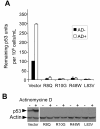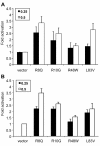Rare human papillomavirus 16 E6 variants reveal significant oncogenic potential
- PMID: 21702904
- PMCID: PMC3144020
- DOI: 10.1186/1476-4598-10-77
Rare human papillomavirus 16 E6 variants reveal significant oncogenic potential
Abstract
The aim of this study was to determine whether low prevalence human papillomavirus (HPV) 16 E6 variants differ from high prevalence types in their functional abilities. We evaluated functions relevant to carcinogenesis for the rarely-detected European variants R8Q, R10G and R48W as compared to the commonly detected L83V. Human immortalized keratinocytes (NIKS) stably transduced with the E6 variants were used in most functional assays. Low and high prevalence E6 variants displayed similar abilities in abrogation of growth arrest and inhibition of p53 elevation induced by actinomycin D. Differences were detected in the abilities to dysregulate stratification and differentiation of NIKS in organotypic raft cultures, modulate detachment induced apoptosis (anoikis) and hyperactivate Wnt signaling. No distinctive phenotype could be assigned to include all rare variants. Like L83V, raft cultures derived from variants R10G and R48W similarly induced hyperplasia and aberrantly expressed keratin 5 in the suprabasal compartment with significantly lower expression of keratin 10. Unlike L83V, both variants, and particularly R48W, induced increased levels of anoikis upon suspension in semisolid medium. R8Q induced a unique phenotype characterized by thin organotypic raft cultures, low expression of keratin 10, and high expression of keratins 5 and 14 throughout all raft layers. Interestingly, in a reporter based assay R8Q exhibited a higher ability to augment TCF/β-catenin transcription. The data suggests that differences in E6 variant prevalence in cervical carcinoma may not be related to the carcinogenic potential of the E6 protein.
Figures






Similar articles
-
Human papillomavirus 16 E6 variants differ in their dysregulation of human keratinocyte differentiation and apoptosis.Virology. 2009 Jan 5;383(1):69-77. doi: 10.1016/j.virol.2008.09.036. Epub 2008 Nov 4. Virology. 2009. PMID: 18986660 Free PMC article.
-
Activities of human papillomavirus 16 E6 natural variants in human keratinocytes.J Med Virol. 2007 Nov;79(11):1751-60. doi: 10.1002/jmv.20978. J Med Virol. 2007. PMID: 17854024
-
Functional effects of sequence variations in the E6 and E2 genes of human papillomavirus 16 European and Asian variants.J Med Virol. 2014 Apr;86(4):618-26. doi: 10.1002/jmv.23792. Epub 2013 Oct 22. J Med Virol. 2014. PMID: 24150786
-
Molecular mechanism of carcinogenesis by human papillomavirus-16.J Dermatol. 2000 Feb;27(2):73-86. doi: 10.1111/j.1346-8138.2000.tb02126.x. J Dermatol. 2000. PMID: 10721654 Review.
-
[Molecular basis of cervical carcinogenesis by high-risk human papillomaviruses].Uirusu. 2008 Dec;58(2):141-54. doi: 10.2222/jsv.58.141. Uirusu. 2008. PMID: 19374192 Review. Japanese.
Cited by
-
Characterization of p16 and E6 HPV-related proteins in uterine cervix high-grade lesions of patients treated by conization with large loop excision.Oncol Lett. 2013 Jul;6(1):63-68. doi: 10.3892/ol.2013.1356. Epub 2013 May 20. Oncol Lett. 2013. PMID: 23946778 Free PMC article.
-
Role of WDHD1 in Human Papillomavirus-Mediated Oncogenesis Identified by Transcriptional Profiling of E7-Expressing Cells.J Virol. 2016 Jun 10;90(13):6071-6084. doi: 10.1128/JVI.00513-16. Print 2016 Jul 1. J Virol. 2016. PMID: 27099318 Free PMC article.
-
Human Papillomavirus Infection in Penile Cancer: Multidimensional Mechanisms and Vaccine Strategies.Int J Mol Sci. 2023 Nov 27;24(23):16808. doi: 10.3390/ijms242316808. Int J Mol Sci. 2023. PMID: 38069131 Free PMC article. Review.
-
HPV16 variants distribution in invasive cancers of the cervix, vulva, vagina, penis, and anus.Cancer Med. 2016 Oct;5(10):2909-2919. doi: 10.1002/cam4.870. Epub 2016 Sep 21. Cancer Med. 2016. PMID: 27654117 Free PMC article.
-
Prevalence of human papillomavirus infection and phylogenetic analysis of HPV-16 E6 variants among infected women from Northern Brazil.Infect Agent Cancer. 2014 Aug 5;9:25. doi: 10.1186/1750-9378-9-25. eCollection 2014. Infect Agent Cancer. 2014. PMID: 25143783 Free PMC article.
References
Publication types
MeSH terms
Substances
Grants and funding
LinkOut - more resources
Full Text Sources
Research Materials
Miscellaneous

